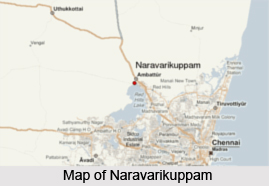 Naravarikuppam is a town and suburb area of Thiruvallur of Tamil Nadu.
Naravarikuppam is a town and suburb area of Thiruvallur of Tamil Nadu.
Location of Naravarikuppam
Naravarikuppam is a town lying in the district of Thiruvallur of the same state of India.
Geography of Naravarikuppam
Naravarikuppam lies approximately at 13.2 degree North to 80.17 degree East. It also rises to a height of 13 meters or 42 feet above the mean sea level.
Demography of Naravarikuppam
The demography of Naravarikuppam published in the year 2001. This report throws light on certain data viz. population status, literacy rate etc. According to this report, Naravarikuppam has showed a population counting of 18,327. Just like many other places of India the number of males also is more than that of females. To support it with evidence Naravarikuppam town`s population status, as has been depicted from the report, has been deduced. As per this report, males constitute 51 % of the population. However female populace constitutes 49 % only. Information about Naravarikuppam`s children also is derived from this report. Children who fall into the age group of less than six years constitute 12 % of the population.
Education of Naravarikuppam
The literacy condition in Naravarikuppam indicates how much growth and development has occurred in a particular town of the country. If its literacy rate is high it rightly established its growth and progress. So far as the average literacy rate of Naravarikuppam is concerned, it enumerates 75 percent, which is even higher than that of the whole country. 59.5 is India`s average literacy rate. A gap exists between male and female literacy rates of Naravarikuppam. In other words, male literacy rate constitutes 81 %. In comparison female literacy rate is less and thus constitute 69 percent.
Economy of Naravarikuppam
Naravarikuppam has the good economical condition. The agriculture of Naravarikuppam and its related practices become the main source of income of the district people. Rice, cumbu - ragi, green gram, black gram, sugar cane and groundnut are principal crops of the district. Also mango, guava and vegetables are grown here. Due to the integrity of the Thiruvallur district it is natural that people of this Naravarikuppam town too stride into the footsteps of the district`s trend and tradition.



















